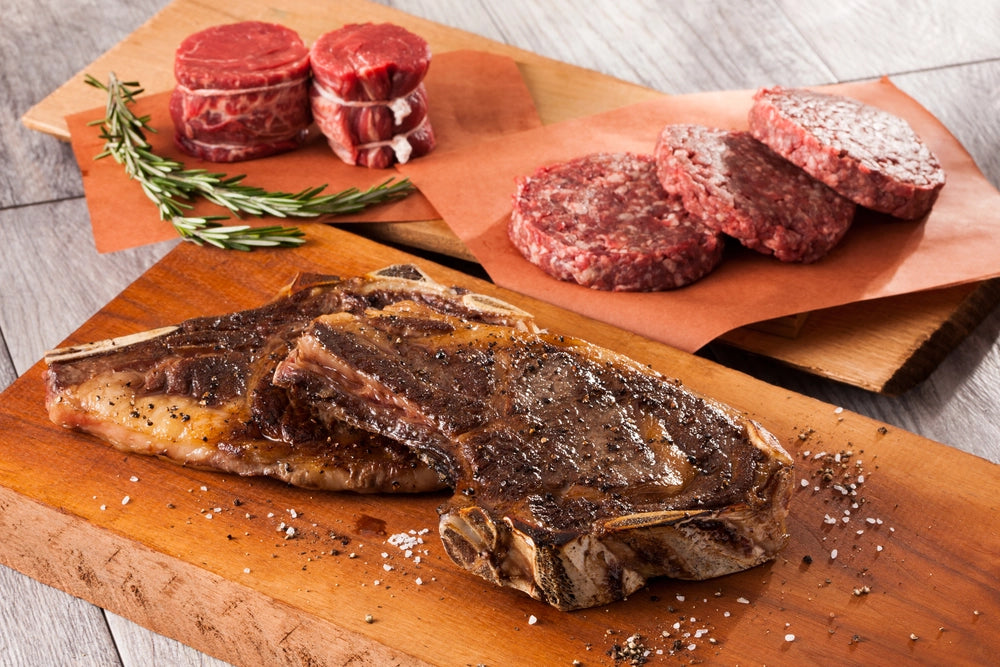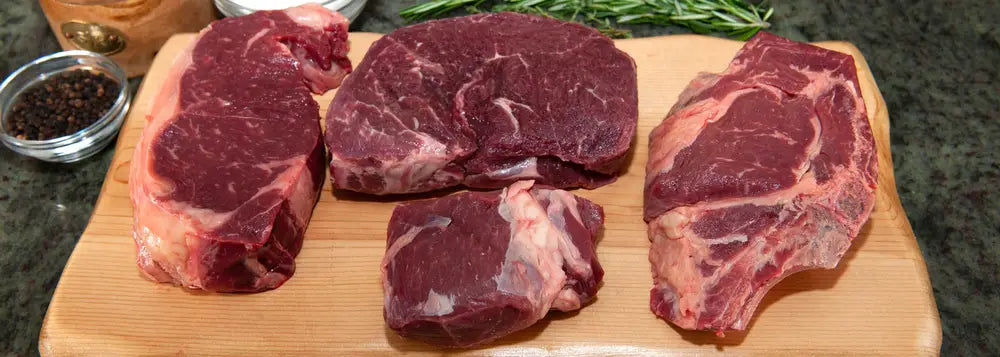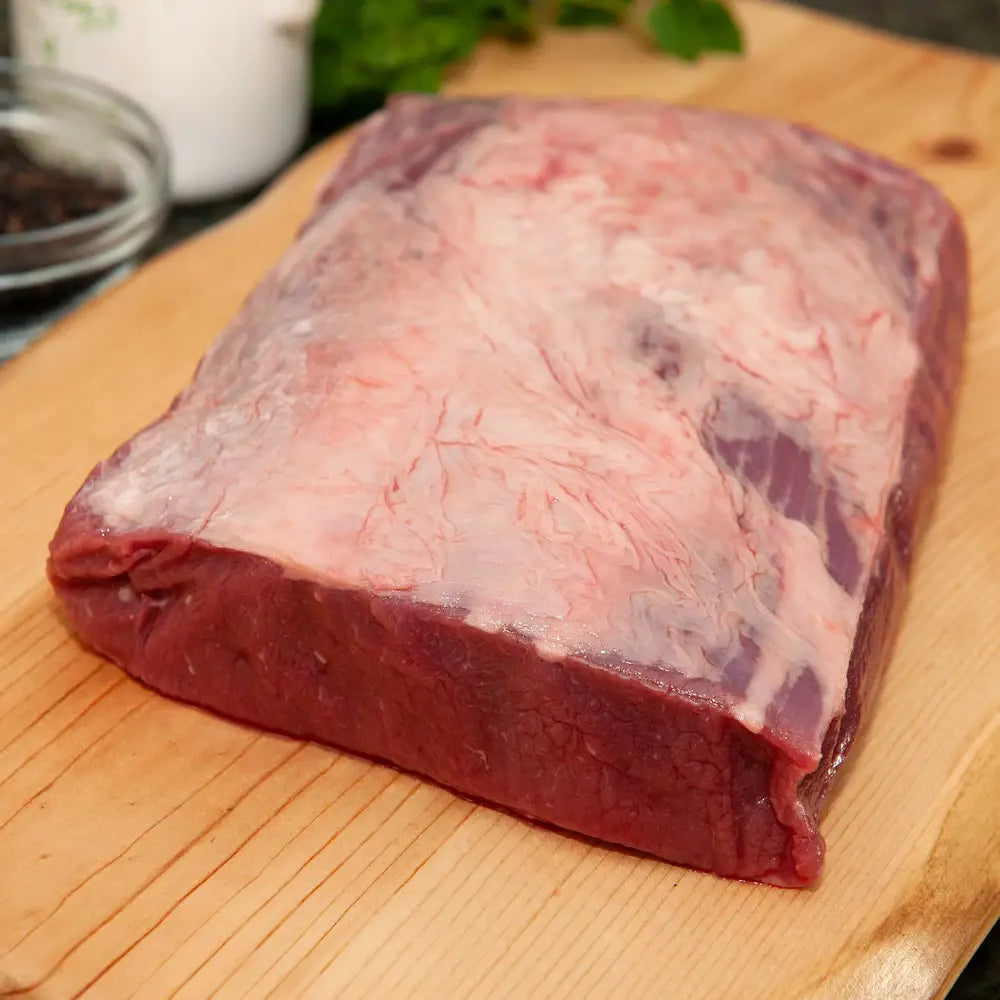As they say, knowledge is power, and nothing could be more true in the kitchen. When it comes to cooking and enjoying beef, understanding the differences between tough and tender cuts is essential. Whether you're slow-cooking a brisket or quickly searing up a juicy ribeye, choosing the right cut for your preferred preparation can mean the difference between bon appetit and a bone-dry bomb.
Here at Acabonac Farms—where our cattle graze freely on lush, grassy pastures—we know every cut has the potential to make a stellar meal. This article will explore the nuances of tough versus tender cuts of beef, helping you understand why sometimes, tough is better and when you should splurge on more premium tender cuts.
Key Takeaways
- Each beef cut offers unique textures and flavors, making some ideal for quick searing, while others benefit from slow cooking to achieve optimal tenderness.
- Generally speaking, tough cuts are more budget-friendly but require longer cooking times.
- Tender cuts are typically more expensive and are quicker to cook.
- Choosing grass-fed, pastured beef from trusted providers like Acabonac Farms ensures the best flavor and nutritional value, regardless of whether you reach for tough or tender cuts.

What Makes a Cut of Beef Tender or Tough?
Understanding the tenderness or toughness of beef cuts starts with a simple observation: the more a muscle is used during an animal's life, the tougher it tends to be. The less it's used, the more tender it is.
A helpful way to determine the potential tenderness of a beef cut is by considering its proximity to the center upper back of the animal. Central cuts from the rib and loin region are typically more tender. Conversely, as one moves away from this center—say, towards the front brisket and lower flank—the cuts become increasingly tough.
To visualize this concept, think of the beef rib area. The muscles here do little work other than supporting the animal's breathing, which is light exertion compared to the constant ground-bearing force on leg muscles. This is why cuts from the rib area, like ribeye and Delmonico steaks, are so tender and sought-after.
In contrast, the leg and shoulder muscles, such as those in the shank and plate region, are responsible for the locomotion of an animal that weighs over 1000 pounds—they’re bound to be tougher because they’re made to work harder.
This principle also applies to other meats such as pork, poultry, and lamb cuts. In each case, the muscles that are used the least yield the most tender cuts, while the most exercised muscles yield the toughest.
What Does Tough Meat Mean?
“Tough meat” refers to cuts that, without preparation, are harder to chew and require more effort to bite through. Toughness is a result of the function and usage of the muscles from which these cuts are derived. Muscles that are weight-bearing or used for movement, such as those in the legs or shoulders, tend to develop denser muscle fibers and a greater amount of connective tissue.
That said, while these cuts may start out tough, they can be made tender by using methods like braising and stewing. These slow, moisture-rich cooking techniques help to soften the meat by breaking down the tough muscle fibers and connective tissues, ultimately transforming these cuts into delicious, fork-tender dishes like boeuf bourginon.
What Does Tender Meat Mean?
Tender meat refers to cuts that are easy to chew and require minimal effort to bite through, even without preparation. These cuts come from less-used parts of the animal, like the muscles that support the animal's body structure or assist with basal functions like breathing.
Since they are used less, they tend to have less developed muscle fibers and fewer connective tissues than muscles used for locomotion, leading to more tender meat. Some popular tender cuts include filet mignon, strip steak, and ribeye.
These tender cuts are particularly well-suited for quick-cooking methods such as grilling, searing, or roasting, and are ideal for those who enjoy their beef cooked to a rare or medium doneness.
Does Beef Get More Tender the Longer You Cook It?
Yes and no. It might seem counterintuitive, but tough cuts of beef get more tender with longer cooking times, while tender cuts of beef become more tough the longer you cook them. Why? It’s all about their internal structure.
Tough cuts have a high amount of connective tissue and collagen that slowly break down into gelatin during prolonged cooking. As these tissues soften to liquid gelatin, the muscle fibers are able to separate more easily—which is why you can flake a properly cooked brisket with a fork. It’s similar to how lamination in baking works—as the pockets of butter in a pie crust or croissant melt in the oven, the steam helps to separate the dough into flaky layers.
Conversely, tender cuts are low in connective tissues, featuring mostly protein and fat. Unlike collagen and connective tissue, when protein is exposed to heat, the long chains begin to break apart and coagulate—a process known as denaturation. As the proteins become denatured, they squeeze out the natural juices.
You can see the denaturation process in real time whenever you cook meat—the surface of the steak, chicken breast, or pork chop contracts when it hits the hot pan. That’s great for creating a tasty crust on your steak, but if you let it go too long, the whole piece will have the same texture as the crust. It's therefore advisable to quickly cook tender cuts to your desired doneness, preferably no more than medium, for the best quality.
How to Identify Tender and Tough Cuts of Beef
Identifying whether a cut of beef is tender or tough is the best way to determine what dishes it's best suited for. Here are several key things to look for:
- Location on the Animal: As discussed earlier, tender cuts generally originate from muscles that see less activity. Notable examples include the tenderloin (also known as filet mignon), ribeye, and sirloin. These are primarily from the mid-upper back of the animal, where there is less movement. In contrast, tough cuts come from areas involving more motion, such as the shoulder (chuck), the rear (round), and the lower leg (shank).
- Marbling: This refers to the intramuscular fat seen as white streaks within the meat, which not only contributes to tenderness but also enhances flavor as the fat melts during cooking.
- Color: Although this is a bit less reliable of a rule, tender cuts generally display a brighter red color, reflecting their higher fat content and lower muscle usage. Tougher cuts generally have a darker, more purplish tint due to their dense muscle fiber and higher myoglobin content.
- Grain: The grain of the meat, or the direction in which the muscle fibers align, can also be a clue. Tender cuts often have finer, less pronounced muscle fibers, while tough cuts will show a coarser, more visible grain pattern.
- Size & Shape: Tender cuts tend to be smaller, more uniformly shaped, and often thicker. Tough cuts, conversely, are often larger, thinner, and more irregularly shaped.
- Connective Tissue: Cuts with more visible gristle or thick bands of connective tissue are typically tougher.
- Price: Generally, tender cuts are more expensive due to their desirable texture and ease of preparation. This is why premium cuts like filet mignon are pricier compared to tougher cuts like brisket or chuck.
While these visual and physical cues are helpful, it's crucial to remember that they are not foolproof. Variations in an animal's age, diet, and the method of meat processing can all influence the appearance and texture of beef cuts. Some less honest meat distributors will even inject their meat with carbon monoxide to make it look fresher and brighter.
As such, the most reliable way to ensure you're selecting the appropriate type of cut for your needs is to both be familiar with the specific names of the cuts and to opt for responsibly raised, pastured beef from a trusted source like Acabonac Farms.

Tough vs Tender Meat: Which Is Better?
When it comes to choosing between tough and tender cuts of beef, neither is inherently better than the other; each has its own strengths and ideal applications. The choice between tough and tender cuts therefore depends on personal taste, cooking style, and the specific requirements of the recipe you're planning to prepare.
Is Tough Meat Better for You?
Tough cuts of meat can offer some nutritional benefits that are less pronounced in tender cuts. First, tough cuts tend to be lower in fat compared to more tender cuts, which might be desirable depending on your dietary goals. Moreover, the fact that tougher cuts are usually more economical, it makes it easier to create protein-rich meals without breaking the bank.
Additionally, because tough cuts require longer cooking times, they can help in breaking down proteins and making nutrients more accessible. For example, the gelatin that results from slow-cooking the connective tissues and collagen in tough cuts is beneficial for joint health and can also aid in digestive health. Tender cuts don’t create nearly as much gelatin.
Keep in mind that grass-fed, pastured beef is higher in essential nutrients like omega-3 fatty acids, vitamins, and antioxidants, and lower in unhealthy fats than conventionally raised beef. As such, you’ll get the most bang for your nutritional buck if you opt for responsibly raised meat from providers like Acabonac Farms.
Is Tougher Meat More Flavorful?
Yes, tough cuts of meat are generally considered more flavorful compared to their tender counterparts. This is due to the higher amounts of muscle fibers, collagen, and connective tissues, which imbue the meat with a deeper, richer beefy taste as they slowly break down during cooking.
When Would You Choose Tough Meat over Tender Meat?
The choice between tough and tender meats largely depends on the specific needs of your meal situation — from the cooking time you can afford to the flavor and texture you desire in your finished dish. Here are several considerations to keep in mind when you’re picking out the best beef for your meal:
- Occasion: Dishes like stews, braises, and pot roasts made from tougher cuts serve many and are usually more cost-effective, making them ideal for feeding a crowd. Tough cuts also hold up well when cooked in bulk, making them ideal for meal prep situations.
- Cooking Time: If you have the luxury of time, choosing a tough cut can be very rewarding. Slow cooking methods unlock the flavors and tenderize the meat, transforming what was once tough into a tender, flavorful meal. This makes tough cuts perfect for weekend meals, slow cooker recipes, or any time where you can allow the dish to braise for several hours.
- Budget: Generally, tough cuts are less expensive than tender cuts, providing a budget-friendly option for everyday meals. The lower cost does not mean compromising on taste, as these cuts often yield rich flavors that are well-suited to a variety of hearty dishes.
- Matching Cuts with Recipes and Cooking Methods: When selecting tough meat, it's important to pair it with the right (read: slow and moist) cooking methods to ensure the best results. For example, a tough cut like a beef chuck shines in a pot roast, where it’s cooked slowly with broth and vegetables. Conversely, if you have less time and want more immediate gratification, tender cuts are the way to go,
Top Tender Cuts of Beef You Should Know
Tender cuts are perfect for when you want a quick, delicious meal that feels fancy. Here’s a guide to some of the most popular tender cuts of beef:
- Tenderloin: Known for being the most tender cut of all, the tenderloin sits beneath the ribs, next to the backbone. This muscle does very little work, which is why it’s so soft. Tenderloin is often cut into steaks known as filet mignon. It’s exceptionally lean, making it a favorite for those looking to enjoy beef without too much fat.
- Ribeye: A favorite of steak eaters everywhere, the ribeye comes from the upper rib section of the animal. This cut is known for its rich marbling, ideal for those who appreciate a juicy, flavorful steak with a soft texture.
- Sirloin: Positioned between the loin and the round, sirloin steaks offer a great balance of tenderness and flavor. While slightly less tender than the ribeye or tenderloin, sirloin steaks have a pleasant chew, are extremely versatile, and provide excellent value.

- Strip Steak: Also known as the New York strip, this cut comes from the short loin. It's known for its fine texture and somewhat firmer bite than the ribeye, with good marbling and deliciously beefy flavor.
Recommended Cooking Methods for Tender Cuts:
- Grilling is perfect for cuts like sirloin and ribeye, where high heat quickly cooks the meat while searing the exterior to a perfect char. Grilling adds a lovely smoky flavor and helps render the fat for extra juicy results.
- Pan-frying a strip steak or sirloin in a hot skillet with a bit of butter or oil seals in the flavors and cooks the steaks to perfection. This method allows for precise control over the cooking temperature, ensuring the meat remains tender and moist.
- Roasting is best suited for larger cuts or whole tenderloins, allowing the heat to envelop the meat, cooking it evenly and retaining its natural juices. Roasting is a great way to prepare a delicious meal that can serve multiple people, perfect for special occasions or family dinners.
Tough Cuts of Beef and How to Make Them Delicious
Tough cuts of beef are often overlooked in favor of their tender counterparts, but with the right preparation and cooking methods, they can yield incredibly flavorful and satisfying dishes. Here are some common tough cuts to try:
- Skirt & Flank: These cuts come from the abdominal muscles of the cow. Skirt steak is known for its flavor, which is intense and beefy, while flank steak is slightly less tender but equally tasty. These cuts benefit from marinating and are popular choices for dishes like fajitas and stir-fries.
- Brisket: Located in the lower chest or breast, brisket is one of the toughest cuts due to the amount of connective tissue. However, when cooked slowly, this cut becomes incredibly tender and flavorful, perfect for smoking, slow-roasting, or braising. If you want the best traditional southern barbecue, you can’t do better than a brisket.

- Shank: This cut comes from the leg portion of the animal and is extremely tough and fibrous. It is typically sold as a cross-cut, featuring a section of the leg bone along with the meat and marrow. It is best used in dishes that cook slowly, like stews and Italian osso buco, where the gelatin can enrich the cooking broth.
- Round: Cut from the hindquarters, the round is lean and less flavorful than some other cuts. It includes sub-cuts like the eye of round, top round, and bottom round. These are best when cooked with moisture, like in a braise or stew.
Recommended Cooking Methods for Tough Cuts:
- Slow Cooking: Using a crockpot or oven set on a low temperature is ideal for cuts like brisket and round. This method allows the heat to slowly permeate the meat, breaking down tough tissues without drying it out.
- Braising: This method involves cooking the meat with a small amount of liquid in a covered pot. It's excellent for cuts like shank and brisket, where the braising liquid can be flavored with herbs, spices, and other aromatics to infuse the meat.
- Stewing: Similar to braising but with more liquid, making a stew is perfect for making the most out of tough cuts. The meat is cut into smaller pieces, which are then cooked slowly in a liquid base with aromatics and veggies, allowing it to become tender enough to eat with a spoon.
Where to Buy Tough Beef or Tender Beef Online
As you delve into the world of beef, we encourage you to experiment with various cuts and cooking techniques to find what best suits your taste and lifestyle. Whether you're looking to master the art of the slow-cooked stew or a perfect seared steak, there's a world of flavors and textures waiting to be explored.
Now, we invite you to explore the wide selection at Acabonac Farms and experience the profound difference in taste and quality that comes with grass-fed beef. Whether you're after a sexy stay-at-home steak dinner for two or a party-ready brisket, we’re excited to bring big, beefy flavor to your table and provide you with the health benefits of responsibly raised meat.

